10.2 Assessing Intelligence
intelligence test a method for assessing an individual’s mental aptitudes and comparing them with those of others, using numerical scores.
achievement test a test designed to assess what a person has learned.
10-
aptitude test a test designed to predict a person’s future performance; aptitude is the capacity to learn.
An intelligence test assesses people’s mental abilities and compares them with others, using numerical scores. How do we design such tests, and what makes them credible? Consider why psychologists created tests of mental abilities and how they have used them.
By this point in your life, you’ve faced dozens of ability tests: school tests of basic reading and math skills, course exams, intelligence tests, driver’s license exams. Psychologists classify such tests as either achievement tests, intended to reflect what you have learned, or aptitude tests, intended to predict your ability to learn a new skill. Exams covering what you have learned in this course are achievement tests. A college entrance exam, which seeks to predict your ability to do college work, is an aptitude test—
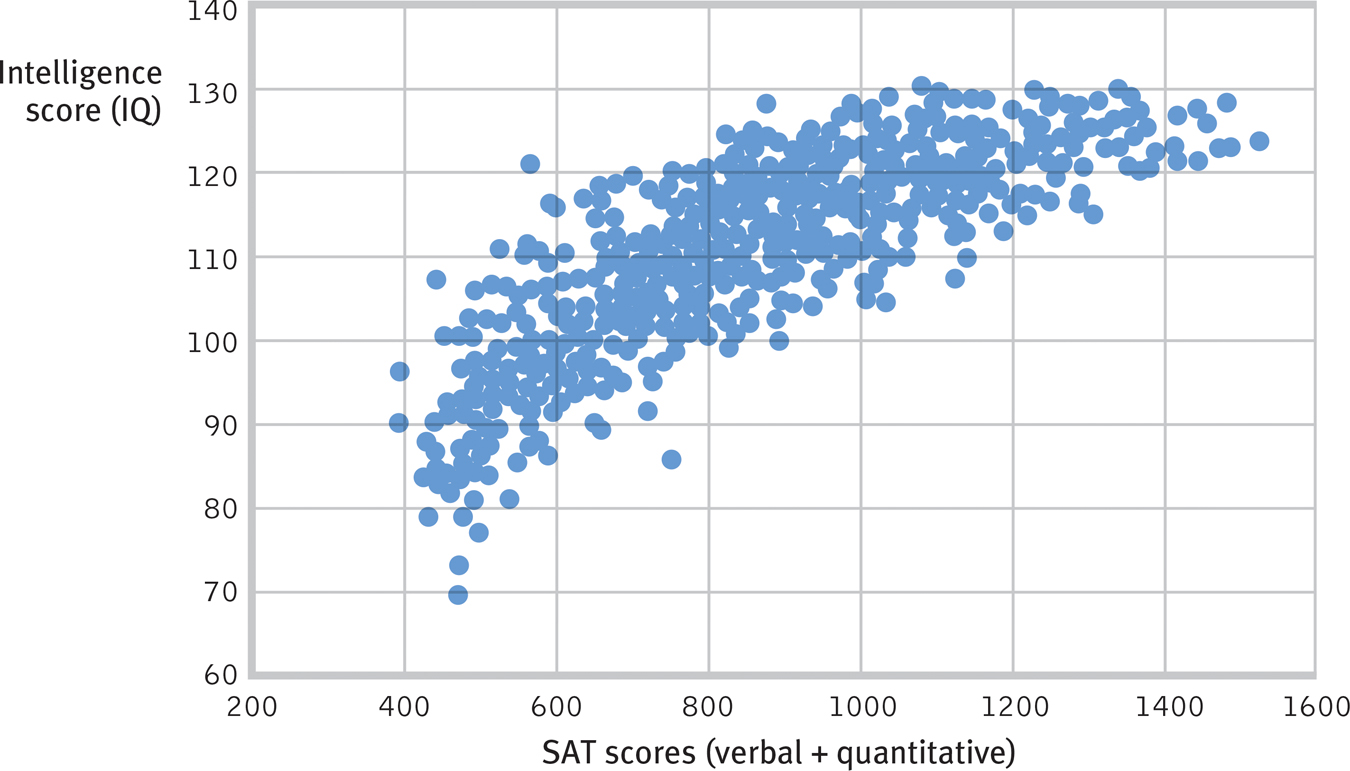
 Figure 10.3
Figure 10.3Close cousins: Aptitude and intelligence scores A scatterplot shows the close correlation that has existed between intelligence scores and verbal and quantitative SAT scores. (Data from Frey and Detterman, 2004.)
393
Early and Modern Tests of Mental Abilities
10-
Some societies concern themselves with promoting the collective welfare of the family, community, and society. Other societies emphasize individual opportunity. Plato, a pioneer of the individualist tradition, wrote more than 2000 years ago in The Republic that “no two persons are born exactly alike; but each differs from the other in natural endowments, one being suited for one occupation and the other for another.” As heirs to Plato’s individualism, people in Western societies have pondered how and why individuals differ in mental ability.
Francis Galton: Belief in Hereditary Genius
Western attempts to assess such differences began in earnest with English scientist Francis Galton (1822–
Although Galton’s quest for a simple intelligence measure failed, he gave us some statistical techniques that we still use (as well as the phrase nature and nurture). And his persistent belief in the inheritance of genius—
Alfred Binet: Predicting School Achievement
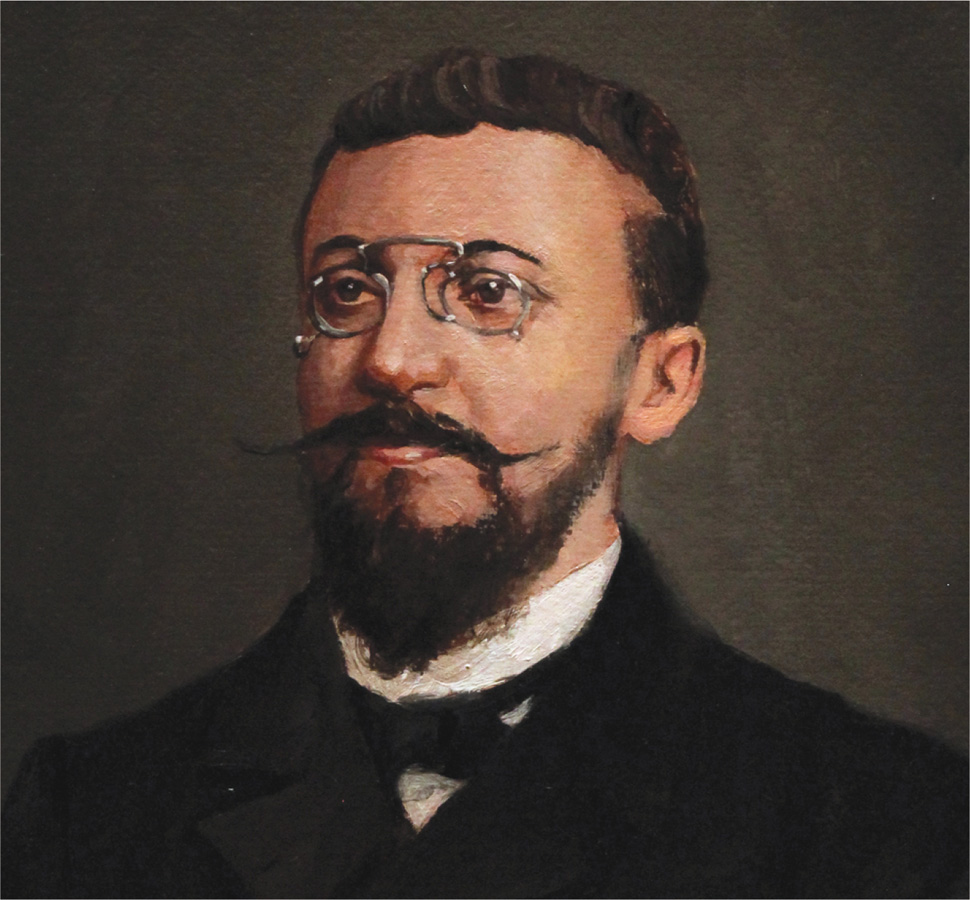
mental age a measure of intelligence test performance devised by Binet; the chronological age that most typically corresponds to a given level of performance. Thus, a child who does as well as an average 8-
Modern intelligence testing traces its birth to early twentieth-
In 1905, Binet and Simon first presented their work under the archaic title, “New Methods for Diagnosing the Idiot, the Imbecile, and the Moron” (Nicolas & Levine, 2012). They began by assuming that all children follow the same course of intellectual development but that some develop more rapidly. On tests, therefore, a “dull” child should score much like a typical younger child, and a “bright” child like a typical older child. Thus, their goal became measuring each child’s mental age, the level of performance typically associated with a certain chronological age. The average 9-
To measure mental age, Binet and Simon theorized that mental aptitude, like athletic aptitude, is a general capacity that shows up in various ways. They tested a variety of reasoning and problem-
394
“The IQ test was invented to predict academic performance, nothing else. If we wanted something that would predict life success, we’d have to invent another test completely.”
Social psychologist Robert Zajonc (1984b)
Binet and Simon made no assumptions concerning why a particular child was slow, average, or precocious. Binet personally leaned toward an environmental explanation. To raise the capacities of low-
RETRIEVAL PRACTICE
- What did Binet hope to achieve by establishing a child’s mental age?
Binet hoped that the child’s mental age (the age that typically corresponds to the child’s level of performance), would help identify appropriate school placements of children.
Stanford-
Lewis Terman: The Innate IQ
intelligence quotient (IQ) defined originally as the ratio of mental age (ma) to chronological age (ca) multiplied by 100 (thus, IQ = ma/ca × 100). On contemporary intelligence tests, the average performance for a given age is assigned a score of 100.
Binet’s fears were realized soon after his death in 1911, when others adapted his tests for use as a numerical measure of inherited intelligence. This began when Stanford University professor Lewis Terman (1877–
From such tests, German psychologist William Stern derived the famous intelligence quotient, or IQ. The IQ is simply a person’s mental age divided by chronological age and multiplied by 100 to get rid of the decimal point:

Thus, an average child, whose mental and chronological ages are the same, has an IQ of 100. But an 8-
The original IQ formula worked fairly well for children but not for adults. (Should a 40-
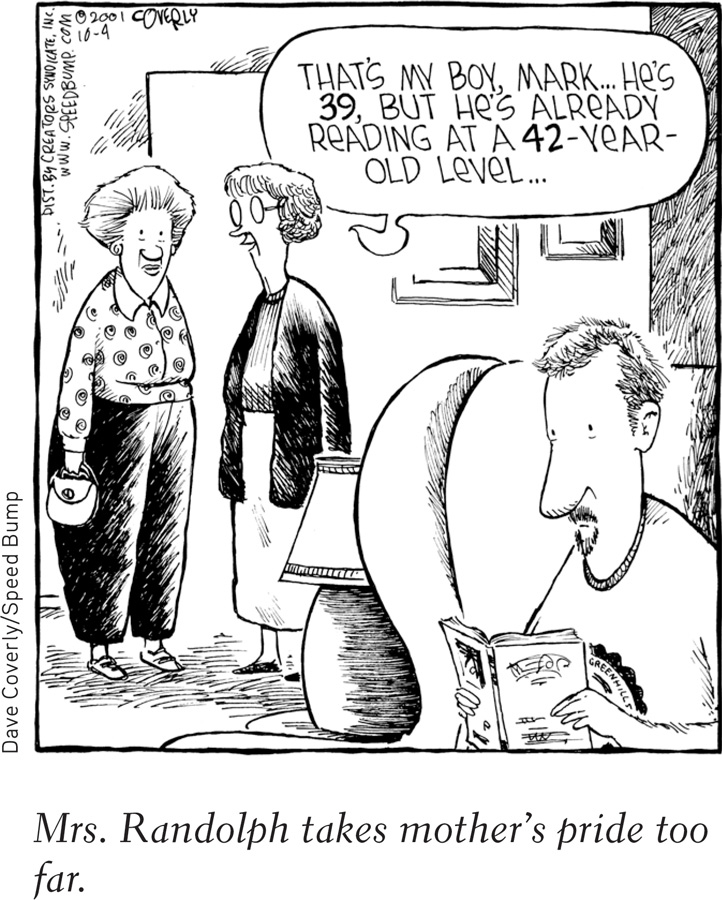
Terman (1916, p. 4) promoted the widespread use of intelligence testing to “take account of the inequalities of children in original endowment” by assessing their “vocational fitness.” In sympathy with Francis Galton’s eugenics—the much-
With Terman’s help, the U.S. government developed new tests to evaluate both newly arriving immigrants and World War I army recruits—
395
Binet probably would have been horrified that his test had been adapted and used to draw such conclusions. Indeed, such sweeping judgments became an embarrassment to most of those who championed testing. Even Terman came to appreciate that test scores reflected not only people’s innate mental abilities but also their education, native language, and familiarity with the culture assumed by the test. Abuses of the early intelligence tests serve to remind us that science can be value-
RETRIEVAL PRACTICE
- What is the IQ of a 4-
year- old with a mental age of 5?
125 (5 ÷ 4 × 100 = 125)
David Wechsler: Separate Scores for Separate Skills
Psychologist David Wechsler created what is now the most widely used individual intelligence test, the Wechsler Adult Intelligence Scale (WAIS), together with a version for school-

- Similarities—Reasoning the commonality of two objects or concepts, such as “In what way are wool and cotton alike?”
- Vocabulary—Naming pictured objects, or defining words (“What is a guitar?”)
- Block Design—Visual abstract processing, such as “Using the four blocks, make one just like this.”
- Letter-
Number Sequencing —On hearing a series of numbers and letters, repeat the numbers in ascending order, and then the letters in alphabetical order: “R-2- C- 1- M- 3.”
Wechsler Adult Intelligence Scale (WAIS) the WAIS and its companion versions for children are the most widely used intelligence tests; contain verbal and performance (nonverbal) subtests.
The WAIS yields not only an overall intelligence score, as does the Stanford-
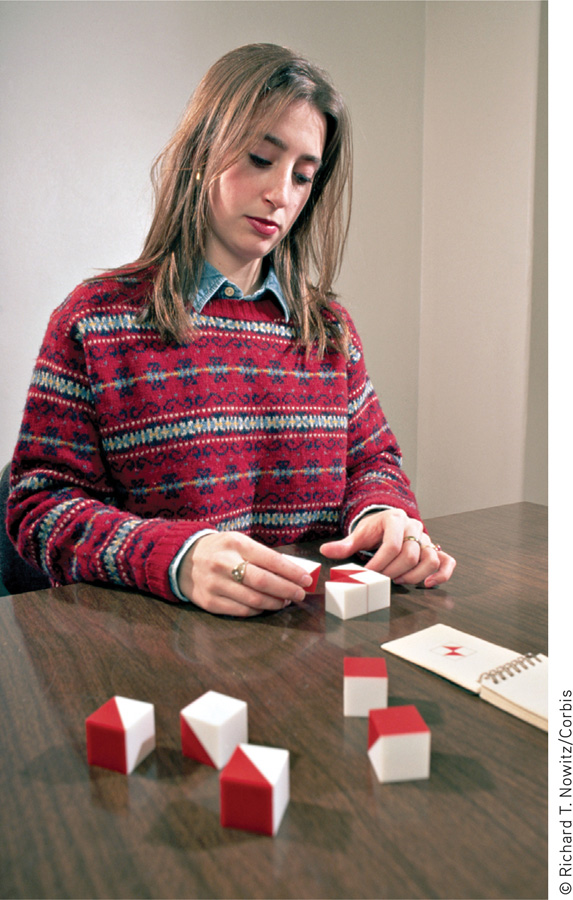
Question
DFtWpQ5cKjO2qAzHInQvQ0bAmugWaVThL4gRhuakzyD7Uw4sMF4quqhXAXtCK5jFlCKaAx3YiBxc89yq6bLxI6z2Atbun1JG0MrvxFkvE+AD6GFtVySbBOU7LfnPZ21mF2BK49AbPt64kcN/ZXD4TJjcQJwiYBGru4CJZqo98ZpD92xHkhnyyclzabcG+wKzBx5FfWil0rNSsUvp9cq0gRiw1k3r3LdyuyQ7s5AW8LADB23dmCb4ag5J+Xo+BTFshRd76ML5PNrHvYE5RETRIEVAL PRACTICE
- An employer with a pool of applicants for a single available position is interested in testing each applicant’s potential. To help her decide whom she should hire, she should use an ______________ (achievement/aptitude) test. That same employer wishing to test the effectiveness of a new, on-
the- job training program would be wise to use an ______________ (achievement/aptitude) test.
aptitude; achievement
Principles of Test Construction
10-
To be widely accepted, a psychological test must meet three criteria: It must be standardized, reliable, and valid. The Stanford-
standardization defining uniform testing procedures and meaningful scores by comparison with the performance of a pretested group.
396
normal curve the bell-
Standardization
The number of questions you answer correctly on an intelligence test would reveal almost nothing. To know how well you performed, you would need some basis for comparison. That’s why test-
If we construct a graph of test-
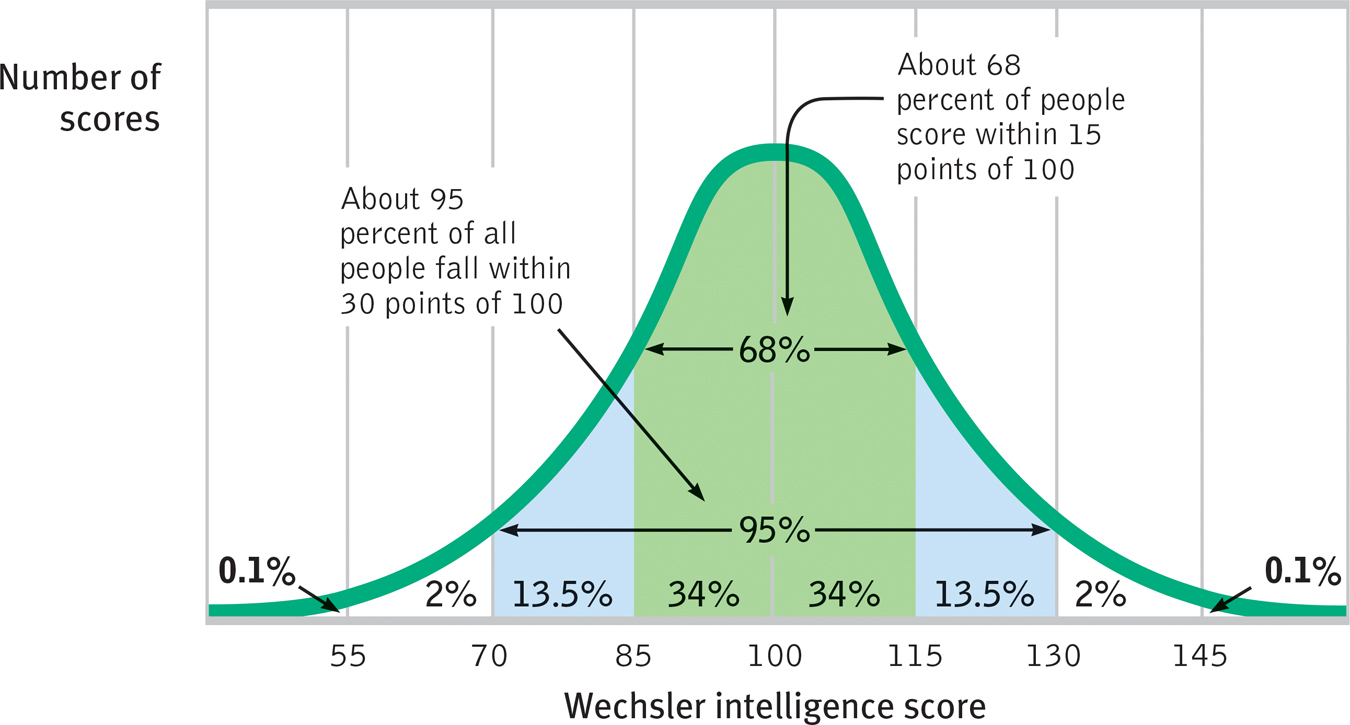
 Figure 10.4
Figure 10.4The normal curve Scores on aptitude tests tend to form a normal, or bell-
To keep the average score near 100, the Stanford-
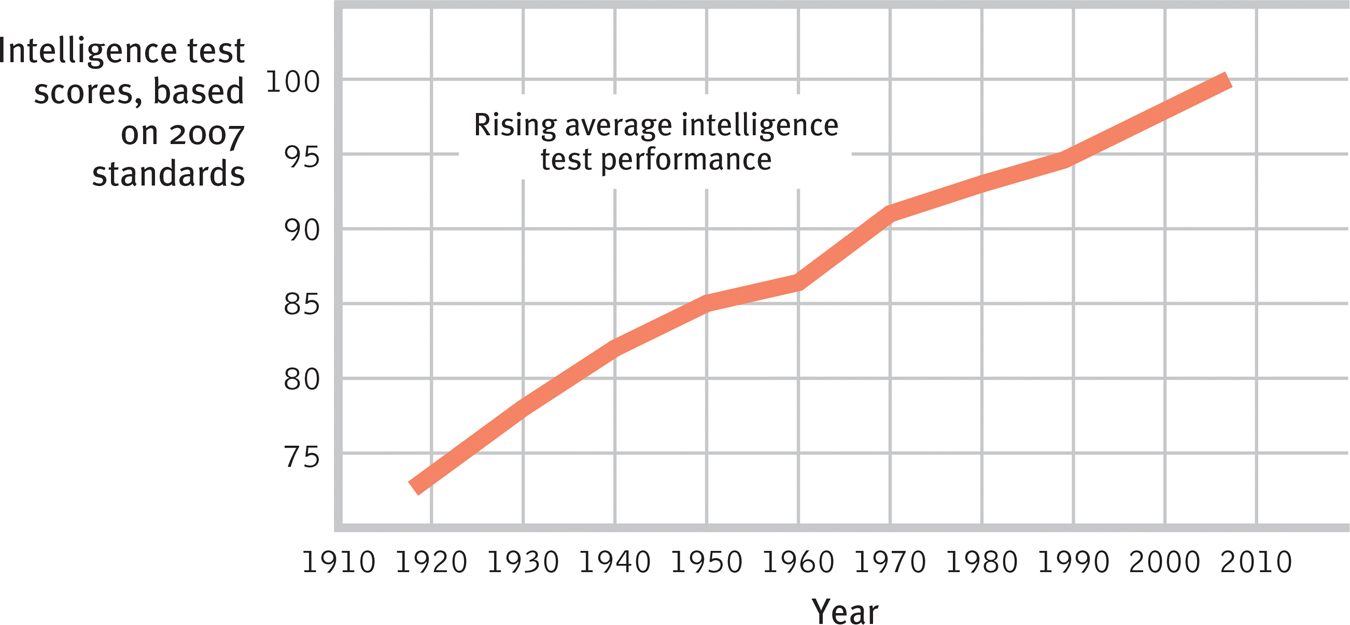
 Figure 10.5
Figure 10.5Getting smarter? In every country studied, intelligence test performance rose during the twentieth century, as shown here with American Wechsler and Stanford-
The Flynn effect’s cause has been a psychological mystery. Did it result from greater test sophistication? But the gains began before testing was widespread and have even been observed among preschoolers. Better nutrition? As the nutrition explanation would predict, people have gotten not only smarter but taller. But in postwar Britain, notes Flynn (2009), the lower-
reliability the extent to which a test yields consistent results, as assessed by the consistency of scores on two halves of the test, on alternative forms of the test, or on retesting.
397
Reliability
validity the extent to which a test measures or predicts what it is supposed to. (See also content validity and predictive validity.)
Knowing where you stand in comparison to a standardization group still won’t say much about your intelligence unless the test has reliability. A reliable test gives consistent scores, no matter who takes the test or when they take it. To check a test’s reliability, researchers test people many times. They may retest using the same test or they may split the test in half to see whether odd-
content validity the extent to which a test samples the behavior that is of interest.
Validity
predictive validity the success with which a test predicts the behavior it is designed to predict; it is assessed by computing the correlation between test scores and the criterion behavior. (Also called criterion-
High reliability does not ensure a test’s validity—the extent to which the test actually measures or predicts what it promises. Imagine using a miscalibrated tape measure to measure people’s heights. Your results would be very reliable. No matter how many times you measured, people’s heights would be the same. But your results would not be valid—
Tests that tap the pertinent behavior, or criterion, have content validity. The road test for a driver’s license has content validity because it samples the tasks a driver routinely faces. Course exams have content validity if they assess one’s mastery of a representative sample of course material. But we expect intelligence tests to have predictive validity: They should predict the criterion of future performance, and to some extent they do.
Are general aptitude tests as predictive as they are reliable? As critics are fond of noting, the answer is plainly No. The predictive power of aptitude tests is fairly strong in the early school years, but later it weakens. Academic aptitude test scores are reasonably good predictors of achievement for children ages 6 to 12, where the correlation between intelligence score and school performance is about +.6 (Jensen, 1980). Intelligence scores correlate even more closely with scores on achievement tests: +.81 in one comparison of 70,000 English children’s intelligence scores at age 11 with their academic achievement in national exams at age 16 (Deary et al., 2007, 2009). The SAT, used in the United States as a college entrance exam, has been less successful in predicting first-
398
Why does the predictive power of aptitude scores diminish as students move up the educational ladder? Consider a parallel situation: Among all American and Canadian football linemen, body weight correlates with success. A 300-
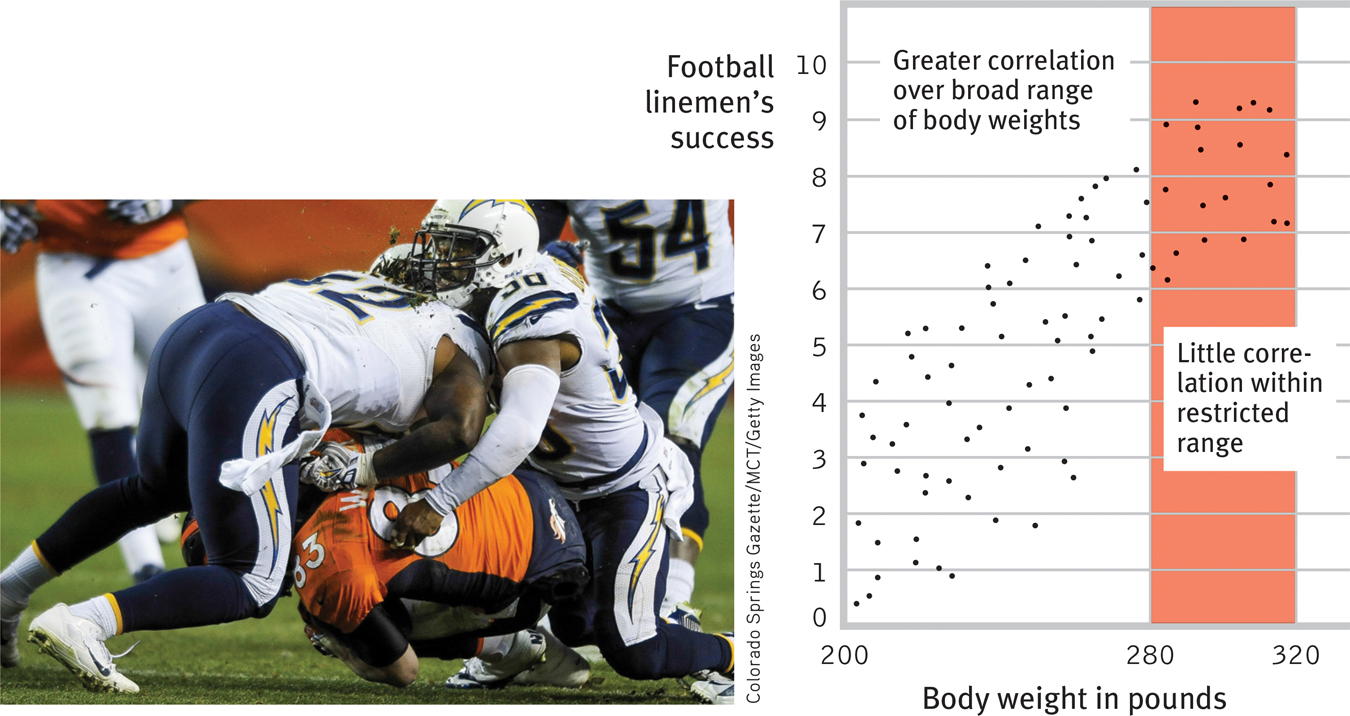
 Figure 10.6
Figure 10.6Diminishing predictive power Let’s imagine a correlation between football linemen’s body weight and their success on the field. Note how insignificant the relationship becomes when we narrow the range of weight to 280 to 320 pounds. As the range of data under consideration narrows, its predictive power diminishes.
Question
tWtb+mPZoxXFDEhHpO5rj+Q69SrkvqT3FCY8BOxSSMMm6iveZR2r0ZTadWhFhJPCvr4IYtl2ouS3GgpLNtZDbHkUXqWTJBJJk49Lj8hVuBvj3bowUYMBHsirn5Pg0q0FNGRXwYjp5JbaITBPekk7LQzW5nwL7lOsvKnYhUzI+HEMoKEITin4LOtSChqO/kFZFix2jywAKa4fScUASaoAzygDt+usyAvhnKnd9xzNg9heChaxNS7bCZTjTg7zj45i0lQuQThCmpaXF5elgDM+SmGSePntSDJU0KVkwA44sh8naiNjooeGlIp+gYGEue8R5ctdQC0uRYE8cylghovfcKqVwd/p1dWZz05j8WwmuN+VtZ+o33Sd2kBVUF0=RETRIEVAL PRACTICE
- What are the three criteria that a psychological test must meet in order to be widely accepted? Explain.
A psychological test must be standardized (pretested on a similar group of people), reliable (yielding consistent results), and valid (measuring what it is supposed to measure).
- Correlation coefficients were used in this section. Here’s a quick review: Correlations do not indicate cause-
effect, but they do tell us whether two things are associated in some way. A correlation of −1.0 represents perfect ______________ (agreement/disagreement) between two sets of scores: As one score goes up, the other score goes ______________ (up/down). A correlation of ______________ represents no association. The highest correlation, +1.0, represents perfect ______________ (agreement/disagreement): As the first score goes up, the other score goes ______________ (up/down).
disagreement; down; zero; agreement; up
399